Hiroshima is a city perfectly suited to exploring on foot. If you prefer to do things on your own schedule this self-guided Hiroshima walking tour with our free digital map will help you explore, ensure you don’t miss anything essential and optimise your time in the city.
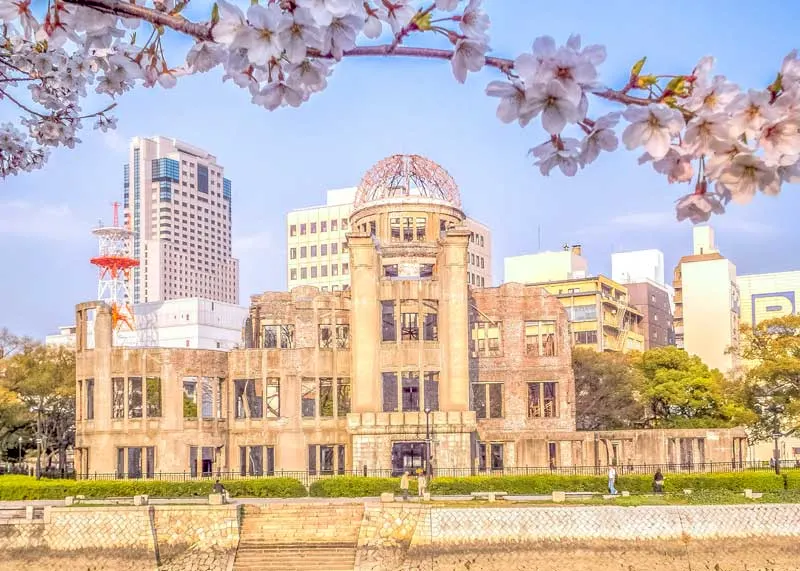
Our first stay in Hiroshima was planned mostly to give us a full day to explore Miyajima Island, it wasn’t until we were sitting on the Shinkansen from Tokyo that I started wondering how I would actually feel wandering around Hiroshima. It’s a city with a relatively recent history and scars that undeniably reflect the hostility that existed between Japan and the West. Would it feel awkward, would the Hiroshima locals be resentful of foreigners?
I needn’t have worried, the city is focused on making the world aware of the horrors of nuclear war but it’s in the name of peace and ensuring that it can never happen again. I will admit to a few quiet tears, it’s an emotional place to visit and makes the full extent of what the human race can inflict on one another all too real. We found the people of Hiroshima without exception to be friendly, welcoming and helpful.
I’d really encourage you to visit the city and take this Hiroshima self-guided walking tour around many of the highlights and must-see spots. The city is flat and quite compact so most people will easily do the whole thing on foot however if you’re short on time or prefer less time on your feet then Hiroshima has an excellent tram system and taxis are readily available.
I’ve started and ended the tour from the station, this is the arrival point for most visitors and there are a number of hotels in the area. If you aren’t in the station precinct you can pick up the tour from your nearest point.
I’ve updated the map recently to be more interactive as more people now have data on their phone when they travel but it can also be downloaded or printed as a static map. I’ve also added a few reference points including convenient tram stops.
So first things first, if you prefer a paper map and don’t have one printed out you will be able to pick up an English street map from the information desk before you leave the station, or at your hotel. They’re readily available, free and they can give you an overview of the area and something to point at if you do need to ask for help along the way.
We also highly recommend renting a WIFI device while you’re in Japan, it makes it so easy to check train timetables, and maps and quickly translate signs and info boards. If you’re weighing up your options to stay connected while travelling around the country we have an article discussing the various free and paid WIFI options.
Table of Contents [show]
Shukkeien
Getting there: From Hiroshima station, you’ll walk 1.2 km in a northeast direction. It’s an easy 15-minute walk to the beautiful gardens of Shukkeien, our first stop. If, like us on our first visit, you find yourself stuck on the Shinkansen side look for the walkway that passes under the station and you’ll pop out on the other side.
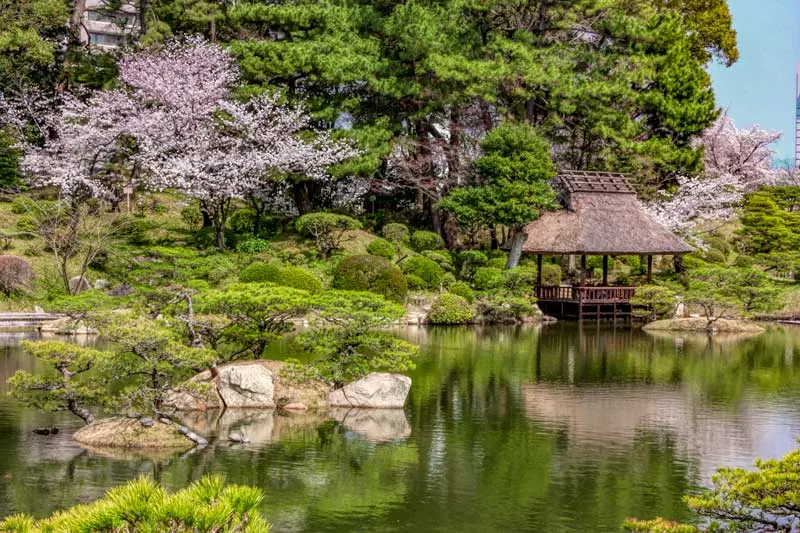
Shukkeien means shrunken scenery garden and it is as if all the elements of the landscape have been reduced to fit into the available space, there are hills and valleys, lakes and forests all beautifully proportioned. The history of the gardens dates back to 1620, just after the completion of Hiroshima Castle.
Although the gardens suffered extensive damage in 1945 from the atomic bomb it also served as a refuge for victims. The garden was rebuilt shortly after and reopened to the public in 1951. Entry to the garden is Y260 and should not be missed, especially during blossom season.
Hiroshima Castle
Getting there: From Shukkeien Garden it’s only a 10 minutes walk (850 metres) to the grounds of Hiroshima Castle.
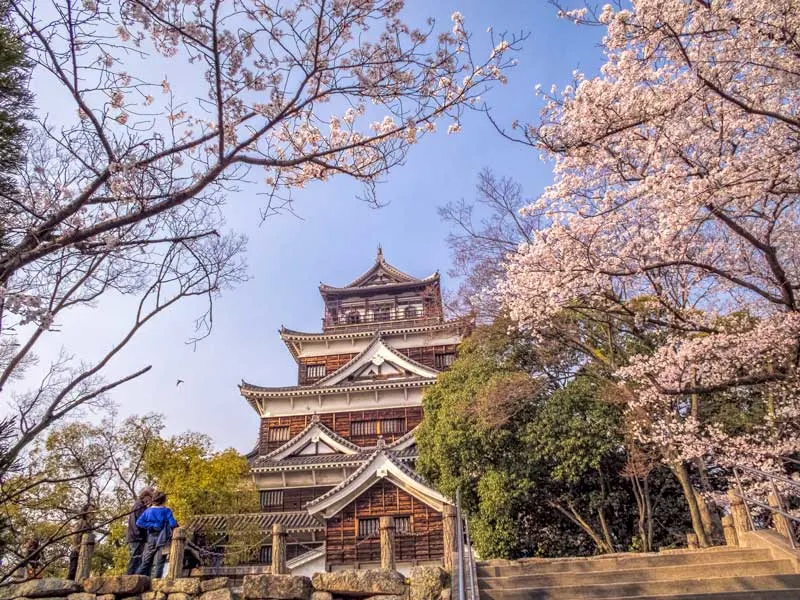
Make your way around the moat edge and the castle ruins to appreciate the castle from all its angles. The original castle was built in 1591 for Terumoto Mori, a feudal lord but being so close to ground zero it was completely destroyed by the atomic bomb blast in 1945. This faithful recreation of the donjon was built in 1958 and the castle site was designated a National Historic Site in 1953.

Gokoku Shrine
Getting there: As you head south from the castle in the direction of the peace park you will pass Gokoku Shrine still within the castle grounds. It’s only around 400 metres and will take less than 5 minutes to get there, it’s directly on the route through the park so you can’t miss it.
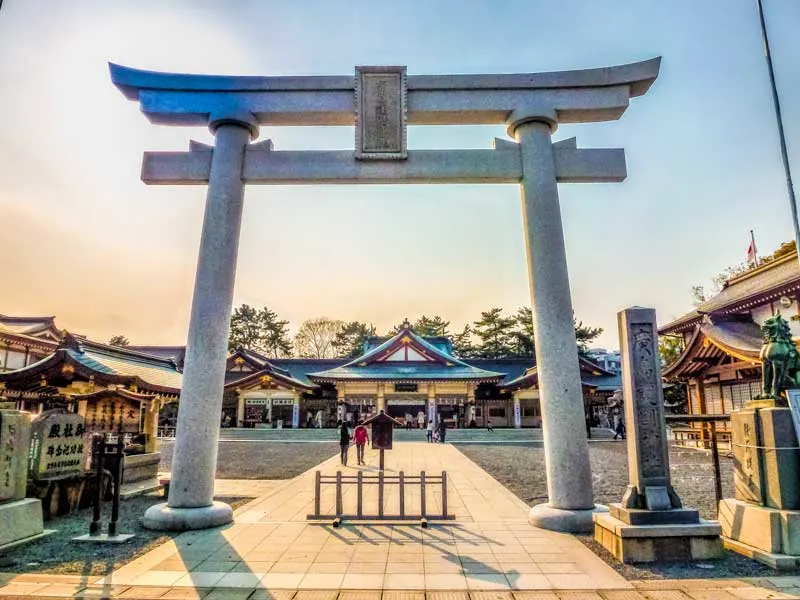
The original Gokoku Shrine was established in 1869, the first year of the Meiji period to honour the victims of the Boshin war. The shrine was moved from its original location to the site of the current baseball stadium in 1934, and to the current site within the Hiroshima Castle grounds in 1956.
All Gokoku Shrines are Shinto Shrines to respect those who died during a war. The Hiroshima Shrine enshrines 92,700 souls including those who died in the city from the atomic bomb. This is the most popular shrine in Hiroshima to celebrate the New Year (Hatsumode) and Shichi go san sai (a celebration for children aged 7, 5 and 3), the Hiroshima baseball team also visit each March to pray for a successful season.
Hiroshima Museum of Art
As you exit the castle grounds the Hiroshima Museum of Art is across the road. It’s an impressively curated small gallery with collections from both western and Japanese artists.
You’ll see intricately painted Japanese screens alongside Picasso, Van Gough, Matisse, Manet, Cezanne and Monet. If you have an interest in art and the time available it’s worth a stop and the garden park it is set in is worth a detour. The museum entry fee is Y1200.
Atomic Bomb Dome
Getting there: Walking a further 15 minutes (1.3 kilometres) mostly through parks and green space will have you at the Atomic Bomb Dome.
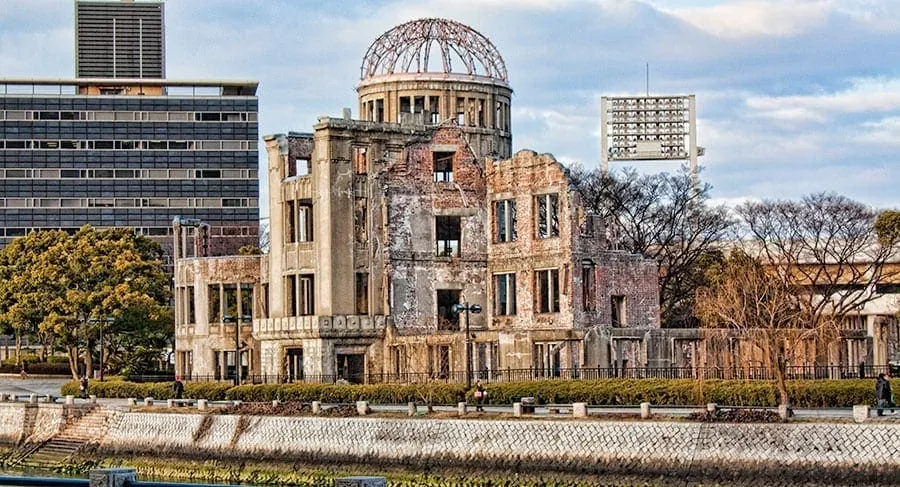
Although it’s located at the epicentre of the devastation from the atomic bomb, the dome is believed to have survived to the extent it has because the bomb detonated directly overhead. Significant work goes into maintaining the safety and appearance of the dome exactly as it was and it’s become a symbol for the ‘Peace City’ of Hiroshima.
Peace Park
Getting there: Walking west and over the bridge from the Atomic Bomb dome, it’s only around 400 metres to the northern end of the Peace Park.
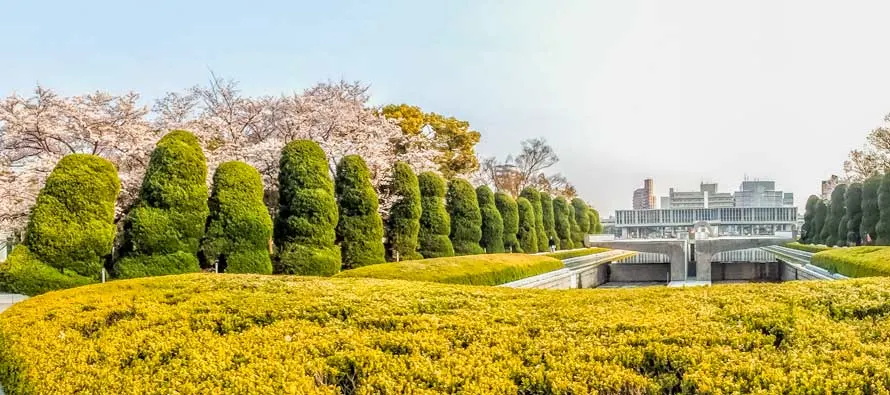
The park itself is quite large and you’ll want to allow a couple of hours if you plan to go through the Peace Museum too. In addition to the museum, you’ll also find the clock tower, a peace bell, the children’s memorial and the flame of peace within the park. The promenade along the river is a popular gathering place and during our spring visit, it was a popular location for Hanami parties.
Shopping and food
Getting there: Heading back east then north towards the station there are many shopping arcades and restaurants. If you’re running short on time there are plenty of tram stops along this route too.
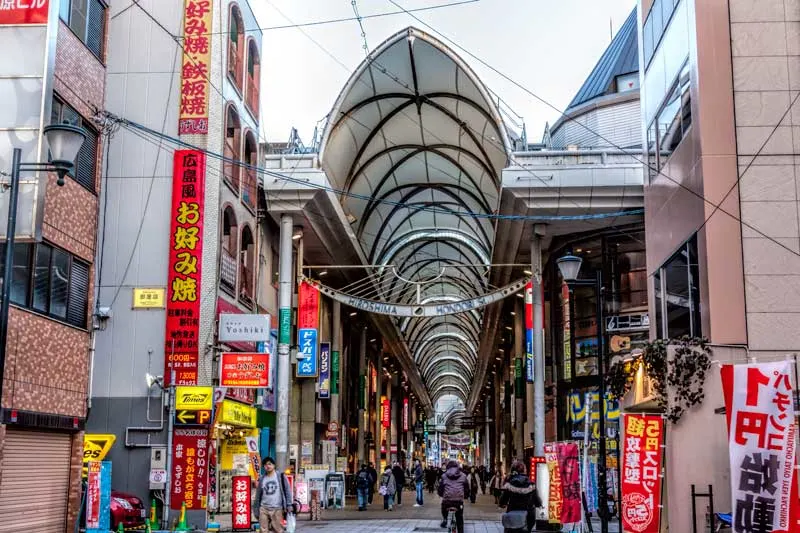
You’ll find pretty much anything you want through this stretch from the more traditional arcades to high-end fashion boutiques. At some point on your trip, I’d definitely recommend ordering Hiroshima okonomiyaki, admittedly I’m a bit of a fan and from time to time we make our own okonomiyaki at home but not in this style.
The local version is quite different to what you’ll order in the rest of Japan, it’s more substantial with the addition of a generous serving of noodles and is cooked in layers rather than the batter of the more familiar Osaka style or Tokyo’s Monjayaki. You’ll find several spots to try this local favourite cooked on a griddle in front of you along this route, there’s also a whole floor of places to try virtually opposite the station.
Head out for the evening bar hopping with a local
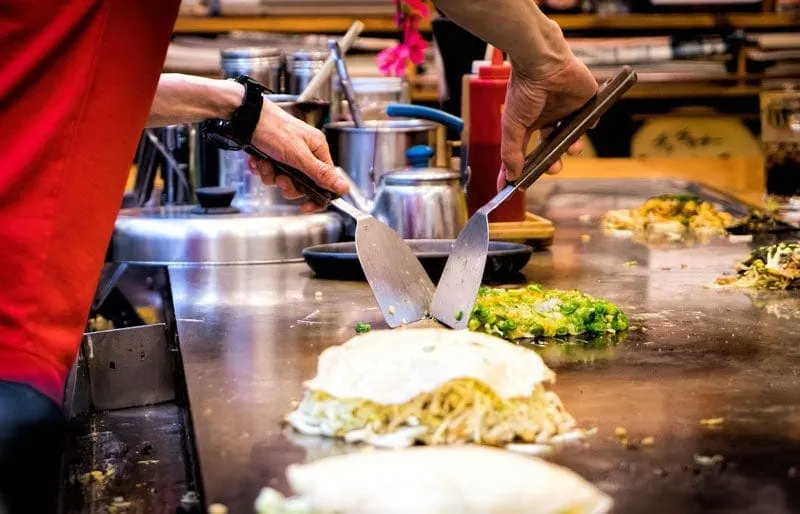
One of the best ways to discover the hidden eating and drinking spots in a new city is with someone who lives there who can show you the places that the locals know but aren’t so known on the tourist trail. An izakaya is a Japanese pub that offers delicious snacks and meals to enjoy alongside your drinks. The best of these bars are often hidden away in the smaller alleyways, not on the main thoroughfares. That can make them difficult for visitors to find on their own.
A great way to try out a few Hiroshima izakaya and foodie spots and enjoy some of the local specialties like oysters, tempura and okonomiyaki is by joining the bar hopping and food tour run by Magical Trip. The tour is led by a Japanese guide who knows the area well and is a fluent English speaker.
During the evening they’ll show you some of their favourite local spots. The guide will also explain izakaya etiquette, tell you about the specialty dishes and leave you with some ideas of places to return and try during the remainder of your time in the city. Best of all this is a small group tour so the evening feels like a night out with friends where one of them can show you the best places to go and answer any questions you have along the way.
Hiroshima Station
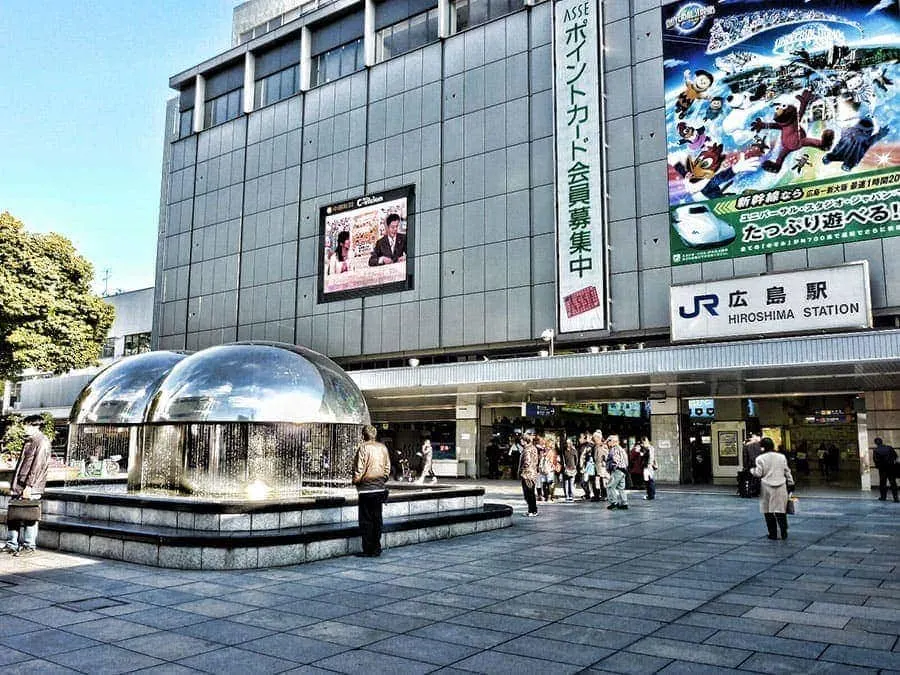
If like many visitors to the city you are arriving and leaving through the station, you are only planning on staying a couple of nights, or you plan to make a day trip to visit Miyajima Island, then the station precinct is a really convenient place to stay.
We’ve stayed in the city a couple of times, the first time at the ANA Crowne Plaza near Peace Park and the second at the Hotel Granvia Hiroshima just outside the station. If we were there again we’d go back to the Granvia, it’s so convenient to drop off and collect your bag for the train and the staff are extremely accommodating. I think this was the only time in Japan when we asked them to hold our bags until check-in time and they offered us our room immediately. The rooms are very nice and the area around the station has a fantastic variety of shops and restaurants.
The local trains and trams run from the opposite side of the station to the hotel and Shinkansen line. The tram hub makes it really convenient to get around but it’s a flat and compact city so walking is easy and the preferred option for us. We get the feel of a city so much faster if we experience it on foot stopping in anywhere that takes our interest along the way.
We really enjoyed our day walking around Hiroshima city, being built almost entirely in the late 1940s and 1950s its styling is simple and quite different to all of the other cities and towns we visited in Japan but we found the people great, the history very interesting and the city is a lively metropolitan space.
We hope you have the chance to take the Hiroshima self-guided walking tour. If you do please let us know your favourite stops in the comments below. If you visit during the cherry blossoms try to allow a little extra time to enjoy the sakura at the garden and hanami parties around the castle moat and the riverbank within the Peace Park.
Interested? Save these to Pinterest
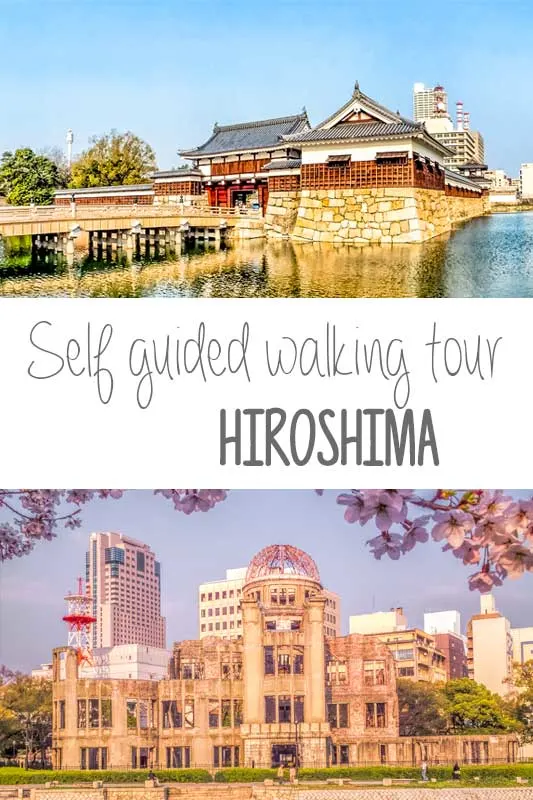
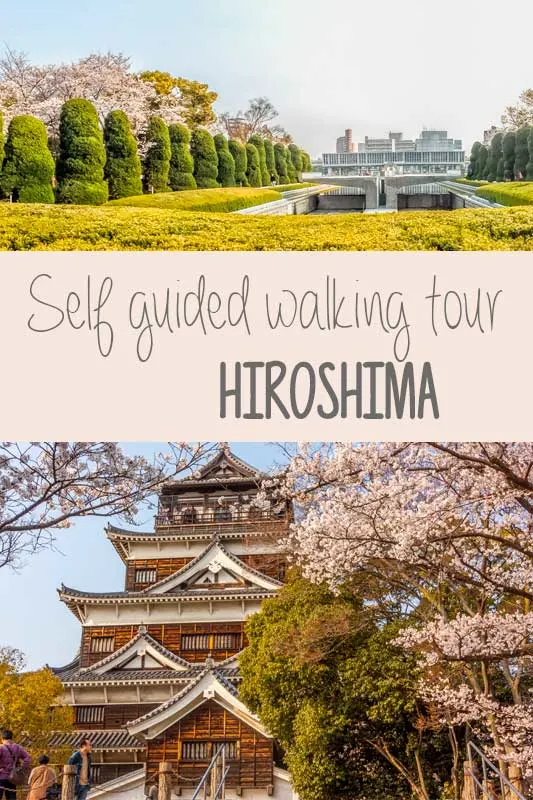
Jason
Wednesday 16th of October 2024
Fabulous advice. Simply, clear, logical, maximises time and gave use a great flavour or Hiroshima along with the main sites. Thanks so much!
Toni Broome
Wednesday 23rd of October 2024
Pleased to hear you enjoyed your time in Hiroshima, thanks Jason
Caroline
Tuesday 3rd of January 2023
Thank you this was fantastic our family of five from Australia used your guide today and really appreciated your easy instructions and advice.
Toni Broome
Wednesday 4th of January 2023
Thanks Caroline, very happy to hear of others enjoying the destinations we love exploring.
L. Brady
Thursday 12th of September 2019
Thanks for a great walking tour. At what point would we be able to get the ferry to Miyajima? Thanks.
Toni Broome
Thursday 12th of September 2019
I have just updated the map to show the Aqua Net Ferry stop that goes from the city to Miyajima. It is located across the river from the Peace Park. If you walk down the river path in front of the A-Bomb Dome you will come to it just past there. The return ferry trip from here is Y3600 (Y4000 from 1 Oct 2019) and is not covered by the JR Pass. For anyone wanting to maximise the use of the JR Pass you take the train from Hiroshima station to MiyajimaGuchi then the ferry from there, both sections are covered by the pass.
Deepika
Thursday 13th of June 2019
Can we get a tour to Hiroshima and miyajima on the 23rd June or 24th June ?
Toni Broome
Thursday 13th of June 2019
The walking tour is designed to do by yourselves (self-guided). The article provides the map, information on the various sites and variations to suit your individual preferences.
Paula Morgan
Tuesday 9th of April 2019
I am booked for next month and allowed 2 nights for Hiroshima. This walk is exactly what I was looking for. Thanks for sharing Toni, I love nothing more than a trialled and tested self-guided walk.
Toni Broome
Tuesday 9th of April 2019
I'm sure you'll have a great time, it's an ideal city to explore on foot. Not long to go now!